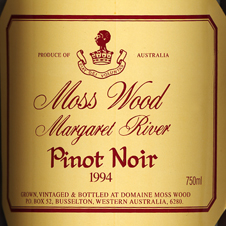Moss Wood 1994 Pinot Noir

Wine Facts
| Harvested: | 28/2/1994 |
| Bottled: | 16/12/1995 |
| Released: | 9/10/1996 |
| Yield: | 11.00 t/ha |
| Baume: | 13.50 |
| Alcohol: | 14.50% |
| Vintage Rating: | 9/10 |
SOLD OUT
Tasting Notes
The 1994 Moss Wood Pinot Noir has a medium to deep red brick hue and a nose that is typical of the variety from this vineyard: aromas of strawberries, plums, red cherries with some spicy, sappy overtones from the inclusion of whole bunches. On the palate, the wine is soft and quite generous with redcurrant and dark cherry flavours as well as the beginnings of some earthy complexity. With bottle ageing, the wine should take on more earthy, gamey characters with possibly a touch of mushroom and truffles. At present, the 1994 Pinot is a neatly balanced red with attractive sweet fruit, moderate acidity and reasonably firm tannins on a soft, oaky finish.
This is a very good example of Moss Wood Pinot and is currently on a par with those produced in 1990 and 1991 but, with bottle development, should rival the great pinot noirs of 1985 and 1986.
Vintage Notes
This was a very good vintage for Margaret River with a great ripe finish following a summer in which the weather was consistently warm but not hot. The temperature rose a few points in February which enabled the vines to ripen quickly. Consequently, instead of the expected gradual picking of pinot noir at Moss Wood, it was necessary to bring all the grapes in as quickly as possible. The condition of the fruit was excellent with no bird damage or disease.
Production Notes
The grapes were crushed with an inclusion of 22% whole bunches: the average has fallen from a peak in the 1988-89 vintages of about 60% to between 20% and 30% at the present time. We believed that the spicy stalky overtones were too dominant in wines that were allowed more than 40% whole bunch inclusion.
In tanks, the must was cooled to 10°C and pumped over twice without yeast inoculation. On the third day, yeasts were introduced and fermentation commenced. Temperatures were allowed to rise to 30°C and the fermenters hand plunged four to six times a day (depending on how vigorous the proprietor was feeling).
At 0° beaume, volunteers were asked to strip naked and jump into the tanks. In this manner, each fermenter received half an hour of pigeage (the action of punching down the skins and other solids to encourage the extraction of colour and tannins and to encourage aeration of the wine). It was commented that there are a surprising lack of female helpers at this stage of the winemaking process (unlike the situation elsewhere) and has indicated that there are some vacancies for willing helpers during the next vintage.
As pigeage results in the treatment of some uncrushed grapes, it also extends the period of fermentation for a few more days. On approximately day 14, the wine was drained and transferred into stainless steel tanks, with all the pressings being included. The wine underwent the malolactic fermentation in stainless steel and is then racked into barrels. It was aged in oak (33% of which was new) for fourteen months before being bottled in December 1995.
Cellaring Notes
The wine has good cellaring potential and will probably be at its best from the age of about 10 years onwards.
